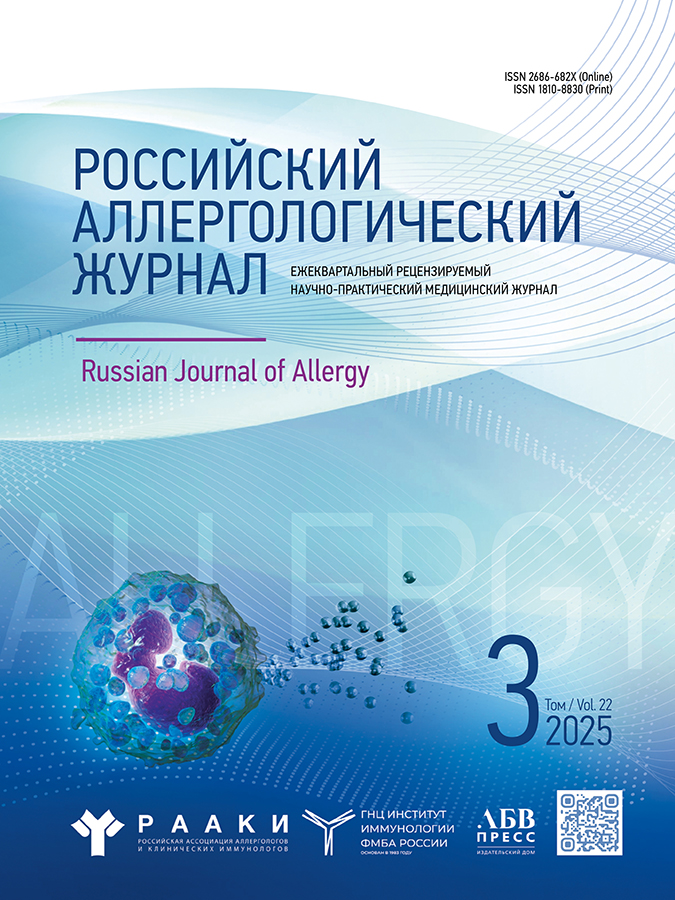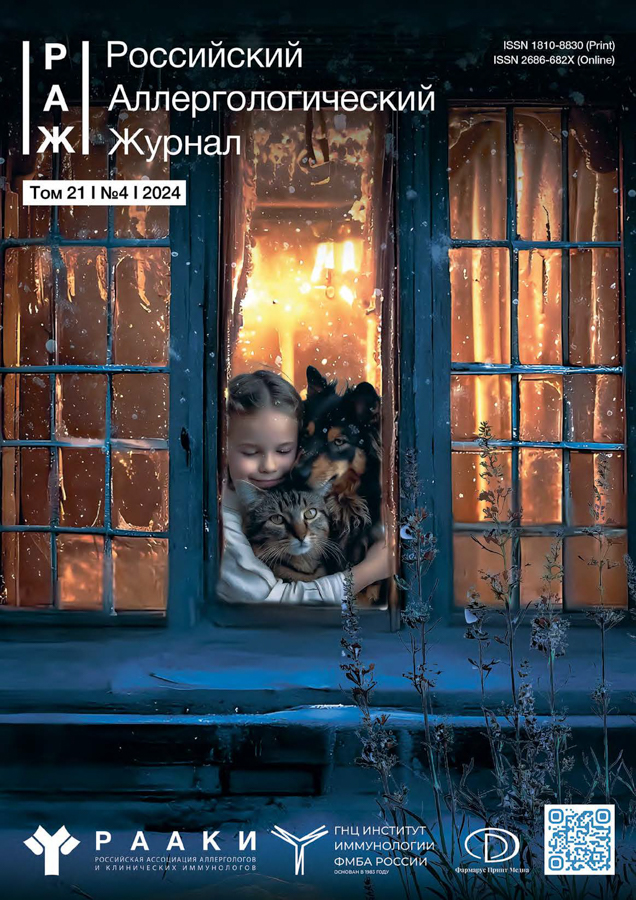Aspects of pathogenesis, differential and modifying approaches in cholinergic urticaria
- Authors: Maltseva N.P.1, Ryabova K.A.2, Zhernov Y.V.2,3, Sebekina O.V.4,5
-
Affiliations:
- State Research Center of Dermatovenerology and Cosmetology
- The First Sechenov Moscow State Medical University (Sechenov University)
- Research Institute of Human Ecology and Environmental Hygiene named after A.N. Sysina, Centre for Strategic Planning and Management of Biomedical Health Risks
- Russian Medical Academy of Continuous Professional Education
- City Clinical Hospital No. 24
- Issue: Vol 21, No 4 (2024)
- Pages: 479-491
- Section: Reviews
- Submitted: 31.05.2024
- Accepted: 05.11.2024
- Published: 28.12.2024
- URL: https://rusalljournal.ru/raj/article/view/16952
- DOI: https://doi.org/10.36691/RJA16952
- ID: 16952
Cite item
Abstract
Cholinergic urticaria is a subtype of chronic inducible urticaria mediated by hyper sweating and clinically manifested by urticarial elements, pruritus and angioedemas. This form of urticaria is of scientific interest considering its high prevalence in particular age groups, prolonged duration, distinct reduction in the quality of life of patients and high risk of developing life-threatening systemic reactions. There are types of anaphylaxis, also occurring due to increased sweating during physical activity. However, although clinical and laboratory characteristics have been described for each of these types, distinct differential diagnostic algorithms between these pathologies and systemic reactions in cholinergic urticaria have not yet been developed. Also, clear recommendations for modification of life style and limitation/elimination of the causal trigger for patients are currently open. These interventions are at the centre of therapy for all inducible forms of chronic urticaria. This article presents a review of the current literature and practical development of recommendations for specialists and patients.
Full Text
About the authors
Natalia P. Maltseva
State Research Center of Dermatovenerology and Cosmetology
Author for correspondence.
Email: maltseva.natalia.p@gmail.com
ORCID iD: 0000-0002-4022-3570
SPIN-code: 2588-5718
Россия, Moscow
Kseniya A. Ryabova
The First Sechenov Moscow State Medical University (Sechenov University)
Email: acksinja@gmail.com
ORCID iD: 0000-0003-0520-0936
SPIN-code: 9000-6894
Россия, Moscow
Yury V. Zhernov
The First Sechenov Moscow State Medical University (Sechenov University); Research Institute of Human Ecology and Environmental Hygiene named after A.N. Sysina, Centre for Strategic Planning and Management of Biomedical Health Risks
Email: zhernov_yu_v@staff.sechenov.ru
ORCID iD: 0000-0001-8734-5527
SPIN-code: 4538-9397
MD, Dr. Sci. (Medicine), Professor
Россия, Moscow; MoscowOksana V. Sebekina
Russian Medical Academy of Continuous Professional Education; City Clinical Hospital No. 24
Email: sebekin1@mail.ru
ORCID iD: 0000-0002-3508-9602
SPIN-code: 2922-9398
MD. Cand. Sci. (Medicine), Assistant Professor
Россия, Moscow; MoscowReferences
- Magerl M, Altrichter S, Borzova E, et al. The definition, diagnostic testing, and management of chronic inducible urticarias: The EAACI/GA2LEN/EDF/UNEV consensus recommendations 2016 update and revision. Allergy. 2016;71(6):780–802. doi: 10.1111/all.12884
- Federal clinical guidelines. Urticaria. Moscow: Russian Association of Allergologists and Clinical Immunologists, Russian Society of Dermatovenerologists and Cosmetologists, 2023. 97 p. (In Russ).
- Zuberbier T, Althaus C, Chantraine-Hess S, Czarnetzki BM. Prevalence of cholinergic urticaria in young adults. J Am Acad Dermatol. 1994;31(6):978–981. doi: 10.1016/s0190-9622(94)70267-5
- Godse K, Farooqui S, Nadkarni N, Patil S. Prevalence of cholinergic urticaria in Indian adults. Indian Dermatol Online J. 2013;4(1):62–63. doi: 10.4103/2229-5178.105493
- Seo JH, Kwon JW. Epidemiology of urticaria including physical urticaria and angioedema in Korea. Korean J Intern Med. 2019;34(2):418–425. doi: 10.3904/kjim.2017.203
- van der Valk PG, Moret G, Kiemeney LA. The natural history of chronic urticaria and angioedema in patients visiting a tertiary referral centre. Br J Dermatol. 2002;146(1):110–113. doi: 10.1046/j.1365-2133.2002.04582.x
- Rujitharanawong C, Tuchinda P, Chularojanamontri L, et al. Cholinergic Urticaria: Clinical Presentation and Natural History in a Tropical Country. Biomed Res Int. 2020;2020:7301652. doi: 10.1155/2020/7301652
- Vadas P, Sinilaite A, Chaim M. Cholinergic Urticaria with Anaphylaxis: An Underrecognized Clinical Entity. J Allergy Clin Immunol Pract. 2016r;4(2):284–291. doi: 10.1016/j.jaip.2015.09.021
- Kounis NG, Kounis GN, Soufras GD. Exercise-induced urticaria, cholinergic urticaria, and Kounis syndrome. J Pharmacol Pharmacother. 2016;7(1):48–50. doi: 10.4103/0976-500X.179355
- Kounis NG, Almpanis G, Tsigkas G, etal. Kounis syndrome following food-dependent exercise-induced anaphylaxis. Intern Med. 2011;50(13):1451. doi: 10.2169/internalmedicine.50.5448
- Fukunaga A, Washio K, Hatakeyama M, et al. Cholinergic urticaria: epidemiology, physiopathology, new categorization, and management. Clin Auton Res. 2018;28(1):103–113. doi: 10.1007/s10286-017-0418-6
- Takahagi S, Tanaka T, Ishii K, et al. Sweat antigen induces histamine release from basophils of patients with cholinergic urticaria associated with atopic diathesis. Br J Dermatol. 2009;160(2):426–428. doi: 10.1111/j.1365-2133.2008.08862.x
- Horikawa T, Fukunaga A, Nishigori C. New concepts of hive formation in cholinergic urticaria. Curr Allergy Asthma Rep. 2009;9(4):273–279. doi: 10.1007/s11882-009-0038-x
- Fukunaga A, Bito T, Tsuru K, et al. Responsiveness to autologous sweat and serum in cholinergic urticaria classifies its clinical subtypes. J Allergy Clin Immunol. 2005;116(2):397–402. doi: 10.1016/j.jaci.2005.05.024
- Kim JE, Jung KH, Cho HH, et al. The significance of hypersensitivity to autologous sweat and serum in cholinergic urticaria: cholinergic urticaria may have different subtypes. Int J Dermatol. 2015:54(7):771–777. doi: 10.1111/ijd.12549
- Kobayashi H, Aiba S, Yamagishi T, et al. Cholinergic urticaria, a new pathogenic concept: Hypohidrosis due to interference with the delivery of sweat to the skin surface. Dermatology. 2002;204(3):173–178. doi: 10.1159/000057877
- Dai X, Okazaki H, Hanakawa Y, et al. Eccrine sweat contains IL-1a, IL-1b and IL-31 and activates epidermal keratinocytes as a danger signal. PLoS One. 2013;8(7):e67666. doi: 10.1371/journal.pone.0067666
- Abajian M, Schoepke N, Altrichter S, et al. Physical urticarias and cholinergic urticaria. Immunol Allergy Clin North Am. 2014;34(1):73–88. doi: 10.1016/j.iac.2013.09.010
- Hiragun T., Ishii K., Hiragun M., et al. Fungal protein MGL_1304 in sweat is an allergen for atopic dermatitis patients. J Allergy ClinImmunol. 2013;132:608–615. doi: 10.1016/j.jaci.2013.03.047
- Murphy GM, Greaves MW, Zollman PE, Winkelmann RK. Cholinergic urticaria, passive transfer experiments from human to monkey. Dermatologica. 1988;177(6):338–340. doi: 10.1159/000248603
- Maltseva NP, Fomina DS, Serdotetskova SA, et al. Cholinergic urticaria: search for predictors of severity of course and response to therapy. Russian Allergological Journal. 2023;20(1):19–28. (In Russ). doi: 10.36691/RJA5379
- Kaplan AP, Gray L, Shaff RE, et al. In vivo studies of mediator release in cold urticaria and cholinergic urticarial. J Allergy Clin Immunol. 1975;55:394–402. doi: 10.1016/0091-6749(75)90078-0
- Soter NA, Wasserman SI, Austen F, et al. Release of mastcell mediators and alterations in lung function in patients with cholinergic urticaria. NEJM. 1980;302(11):604–608. doi: 10.1056/NEJM198003133021104
- Sawada Y, Nakamura M, Bito T, et al. Decreased expression of acetylcholine esterase in cholinergic urticaria with hypohidrosis or anhidrosis. J Investigative Dermatol. 2014;134:276–279. doi: 10.1038/jid.2013.244
- Munetsugu T, Fujimoto T, Oshima Y, et al. Revised guideline for the diagnosis and treatment of acquired idiopathic generalized anhidrosis in Japan. J Dermatol. 2017;44(4):394–400. doi: 10.1111/1346-8138.13649
- James MP, Eady RA, Kobza-Black A, et al. Physical urticaria: a microscopical and pharmacological study of mast cell involvement, abstracted. J Invest Dermatol. 1980;74:451.
- Winkelmann RK. The histology and immunopathology of dermographism. J CutanPathol. 1985;12(6):486–492. doi: 10.1111/j.1600-0560.1985.tb00447.x
- Illig L, Heinicke A. Zur. pathogenese der cholinergischen urticaria. IV. Zur Frageeinerechten Antigen-Antikörperreaktion [On the pathogenesis of cholinergic urticaria. IV. On the problem of a true antigen-antibody reaction]. Arch KlinExpDermatol. 1967;229(4):360–371.
- Shelley WB, Shelley ED. Follicular dermographism. Cutis. 1983;32(3):244–260.
- Nakamizo S, Egawa G, Miyachi Y, Kabashima K. Cholinergic urticaria: Pathogenesis-based categorization and its treatment options. J Eur Acad Dermatol Venereology. 2012;26(1):114–116. doi: 10.1111/j.1468-3083.2011.04017.x
- Czarnetzki BM. Ketotifen in cholinergic urticaria. J Allergy Clin Immunol. 1990;86(1):138–139. doi: 10.1016/s0091-6749(05)80136-8
- Ruft J, Asady A, Staubach P, et al. Development and validation of the Cholinergic Urticaria Quality-of-Life Questionnaire (CholU-QoL). ClinExp Allergy. 2018;48(4):433–444. doi: 10.1111/cea.13102
- Mikhailov P, Berova N, Andreev VC. Physical urticaria and sport. Cutis. 1977;20(3):381–390.
- Hirschmann JV, Lawlor F, English JS, et al. Cholinergic urticaria. A clinical and histologic study. Arch Dermatol. 1987;123(4):462–467. doi: 10.1001/archderm.123.4.462
- Volcheck GW, Li JT. Exercise-induced urticaria and anaphylaxis. Mayo Clin Proc. 1997;72(2):140–147. doi: 10.4065/72.2.140
- Sheffer AL, Austen KF. Exercise-induced anaphylaxis. J Allergy Clin Immunol. 1980;66(2):106–111. doi: 10.1016/0091-6749(80)90056-1
- Foong R, Giovannini M, Toit G. Food-dependent exercise-induced anaphylaxis. Curr Opin Allergy Clin Immunol. 2019;19(3):224–228. doi: 10.1097/ACI.0000000000000531
- Maurer M, Fluhr JW, Khan DA. How to Approach Chronic Inducible Urticaria. J Allergy Clin Immunol Pract. 2018;6(4):1119–1130. doi: 10.1016/j.jaip.2018.03.007
- Borzova EY, Popova KY, Kurowski M, et al. Cholinergic urticaria: new aspects of pathogenesis, diagnosis and therapy. Russian Journal of Skin and Venereal Diseases. 2021;24(3):211–226. (In Russ). doi: 10.17816/dv72329
- Chen JY, Quirt J, Lee KJ. Proposed new mechanism for food and exercise induced anaphylaxis based on case studies. Allergy Asthma Clin Immunol. 2013;9(1):11. doi: 10.1186/1710-1492-9-11
- Kulthanan K, Ungprasert P, Jirapongsananuruk O, et al. Food-Dependent Exercise-Induced Wheals, Angioedema, and Anaphylaxis: A Systematic Review. J Allergy Clin Immunol Pract. 2022;10(9):2280–2296. doi: 10.1016/j.jaip.2022.06.008
- Longley S, Panush RS. Familial exercise-induced anaphylaxis. Ann Allergy. 1987;58:257–259.
- Grant JA, Farnam J, Lord RA, et al. Familial exercise-induced anaphylaxis. Ann Allergy. 1985;54:35–38.
- Baadsgaard O, Lindskov R. Cholinergic urticaria with anaphylaxis induced by exercise or heating. Acta DermVenereol (Stockh). 1984;64: 344–346.
- Kaplan AP, Natbony SF, Tawil AP, et al. Exercise-induced anaphylaxis as a manifestation of cholinergic urticaria. J Allergy Clin Immunol. 1981;68(4):319–324. doi: 10.1016/0091-6749(81)90158-5
- Castells MC, Horan RF, Sheffer AL. Exercise-induced Anaphylaxis. Curr Allergy Asthma Rep. 2003;3(1):15–21. doi: 10.1007/s11882-003-0005-x
- Kiistala R, Kiistala U. Local cholinergic urticaria at methacholine test site. Acta Derm Venereol. 1997;77(1):84–85. doi: 10.2340/00015555778485
- Komarow HD, Arceo S, Young M, et al. Metcalfe dissociation between history and challenge in patients with physical urticarial. J Allergy Clin Immunol Pract. 2014;2(6):786–790. doi: 10.1016/j.jaip.2014.07.008
- Murphy GM, Black AK, Greaves MW. Persisting cholinergic erythema: a variant of cholinergic urticaria. Br J Dermatol. 1983;109(3):343–348. doi: 10.1111/j.1365-2133.1983.tb03551.x
- Mayou SC, Kobza Black A, Eady RA, Greaves MW. Cholinergic dermographism. Br J Dermatol. 1986;115(3):371–377. doi: 10.1111/j.1365-2133.1986.tb05754.x
- Montgomery MD. Cholinergic urticaria and exercise-induced anaphylaxis. Curr Sports Med Rep. 2015;14(1):61–63. doi: 10.1249/jsr.0000000000000111
- Bizjak M, Košnik M, Dinevski D, et al. Adrenaline autoinjector is underprescribed in typical cold urticaria patients. Allergy. 2022;77(7):2224–2229. doi: 10.1111/all.15274
- Wanderer AA. Cold urticaria syndromes: historical background, diagnostic classification, clinical and laboratory characteristics, pathogenesis, and management. J Allergy Clin Immunol. 1990;85(6):965–981. doi: 10.1016/0091-6749(90)90037-5
- Maltseva N, Borzova E, Fomina D, et l. COLD-CE Steering Committee. Cold urticaria – What we know and what we do not know. Allergy. 2021;76(4):1077–1094. doi: 10.1111/all.14674
- Kocatürk E, Kızıltaç U, Can P, et al. Validation of the Turkish version of the Urticaria Control Test: Correlation with other tools and comparison between spontaneous and inducible chronic urticaria. World Allergy Organ J. 2019;12(1):100009. doi: 10.1016/j.waojou.2018.11.007
- Khoshkhui M, Weller K, Fadaee J, et al. Iran Evaluation of the Reliability and Validity of the Persian Version of Urticaria Control Test (UCT). J Allergy Asthma Immunol. 2021;20(4):423–431.
- Al Otaibi HM, Al Furayh NA, Al Nooh BM, et al. Quality of life assessment among patients suffering from different dermatological diseases. Saudi Med J. 2021;42(11):1195–1200. doi: 10.15537/smj.2021.42.11.20210560
- Weller K, Groffik A, Church MK, et al. Development and validation of the Urticaria Control Test: a patient-reported outcome instrument for assessing urticaria control. J Allergy Clin Immunol. 2014;133(5):1365–1372. doi: 10.1016/j.jaci.2013.12.1076
- Koch K, Weller K, Werner A, et al. Antihistamine updosing reduces disease activity in patients with difficult-to-treat cholinergic urticaria. J Allergy Clin Immunol. 2016;138(5):1483–1485.e9. doi: 10.1016/j.jaci.2016.05.026
- Finlay AY, Khan GK. Dermatology Life Quality Index (DLQI) – a simple practical measure for routine clinical use. Clin Exp Dermatol. 1994;19:210–216. doi: 10.1111/j.1365-2230.1994.tb01167.x
- Itakura A, Tani Y, Kaneko N, Hide M. Impact of chronic urticaria on quality of life and work in Japan: Results of a real-world study. J Dermatol. 2018;45(8):963–970. doi: 10.1111/1346-8138.14502
- Duke WW. Urticaria caused specifically by the action of physical agents. J Am Med Assoc. 1924;5:3–9.
Supplementary files





